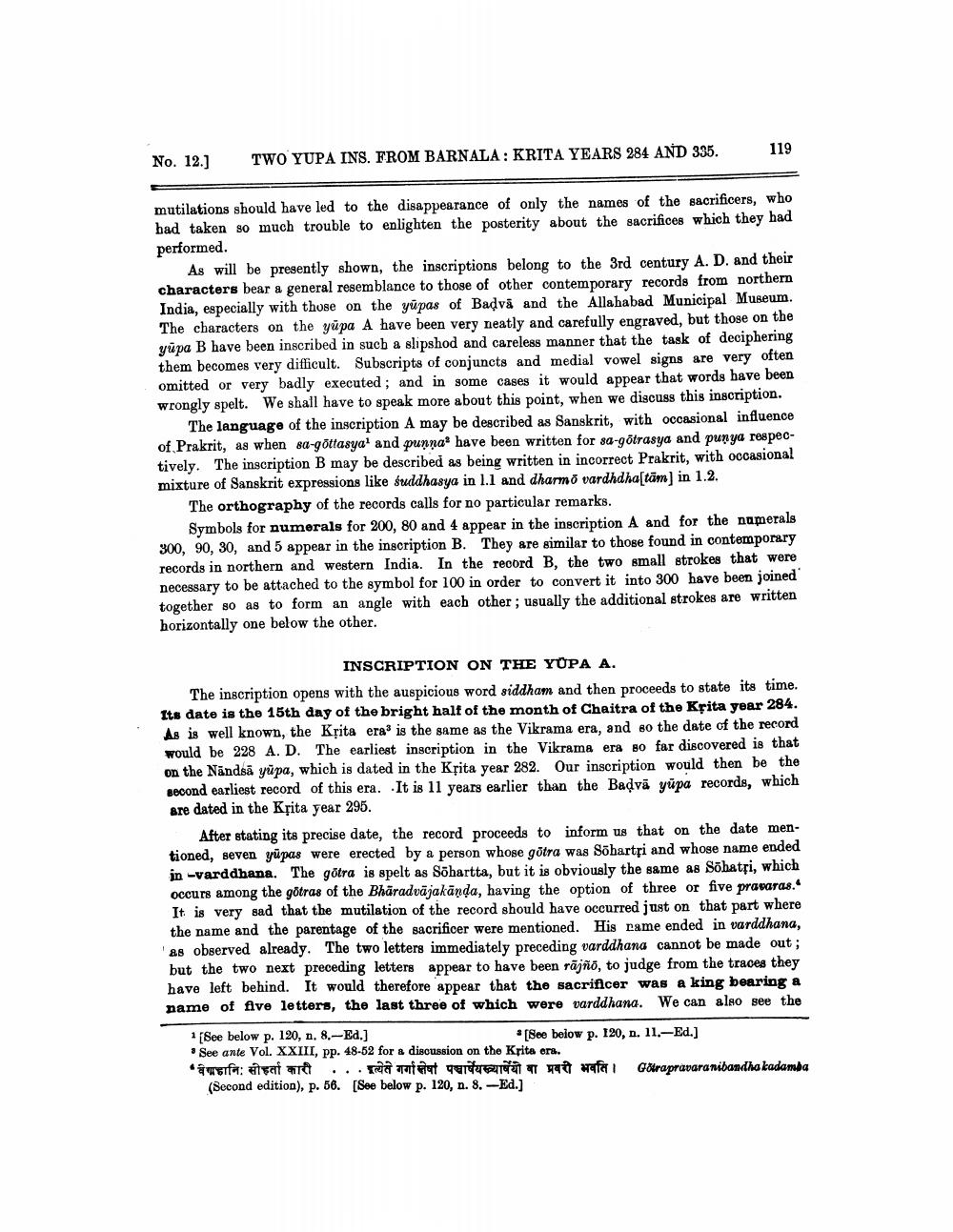________________
No. 12.]
TWO YUPA INS. FROM BARNALA: KRITA YEARS 284 AND 335.
119
mutilations should have led to the disappearance of only the names of the sacrificers, who bad taken so much trouble to enlighten the posterity about the sacrifices which they had performed.
As will be presently shown, the inscriptions belong to the 3rd century A. D. and their characters bear a general resemblance to those of other contemporary records from northern India, especially with those on the yūpas of Badva and the Allahabad Municipal Museum. The characters on the yüpa A have been very neatly and carefully engraved, but those on the yüpa B have been inscribed in such a slipshod and careless manner that the task of deciphering them becomes very difficult. Subscripts of conjuncts and medial vowel signs are very often omitted or very badly executed ; and in some cases it would appear that words have been wrongly spelt. We shall have to speak more about this point, when we discuss this inscription.
The language of the inscription A may be described as Sanskrit, with occasional influence of Prakrit, as when sa-gottasyal and punna have been written for sa-gotrasya and punya respectively. The inscription B may be described as being written in incorrect Prakrit, with occasional mixture of Sanskrit expressions like suddhasya in l.1 and dharm o vardhdha[tām) in 1.2.
The orthography of the records calls for no particular remarks.
Symbols for numerals for 200, 80 and 4 appear in the inscription A and for the numerals 800, 90, 30, and 5 appear in the inscription B. They are similar to those found in contemporary records in northern and western India. In the reoord B, the two small strokes that were necessary to be attached to the symbol for 100 in order to convert it into 300 have been joined together so as to form an angle with each other, usually the additional strokes are written horizontally one below the other.
INSCRIPTION ON THE YUPA A. The inscription opens with the auspicious word siddham and then proceeds to state its time. Its date is the 15th day of the bright half of the month of Chaitra of the Krita year 284. As is well known, the Kțita era is the same as the Vikrama era, and so the date of the record would be 228 A. D. The earliest inscription in the Vikrama era so far discovered is that on the Nändsä yüpa, which is dated in the Ksita year 282. Our inscription would then be the second earliest record of this era. It is 11 years earlier than the Badvä yüpa records, which are dated in the Ksita year 295.
After stating its precise date, the record proceeds to inform us that on the date mentioned, seven yūpas were erected by a person whose götra was Sõbartpi and whose name ended in-varddhana. The gotra is spelt as Söhartta, but it is obviously the same as Sõbatsi, which occurs among the gotras of the Bhāradväjakānda, having the option of three or five pravaras. It is very sad that the mutilation of the record should have occurred just on that part where the name and the parentage of the sacrificer were mentioned. His name ended in varddhana, as observed already. The two letters immediately preceding varddhana cannot be made out; but the two next preceding letters appear to have been rājño, to judge from the traces they have left behind. It would therefore appear that the sacrificer was a king bearing a name of five letters, the last three of which were varddhana. We can also see the
1 [See below p. 120, n. 8.-Ed.]
[See below p. 120, n. 11.-Ed.] See ante Vol. XXIII, pp. 48-52 for a discussion on the Krita era. aufa: tai .. rament qurulu 40 wafai GXrapravaranibandha kadamba
(Second edition), p. 56. [See below p. 120, n. 8. -Ed.]




